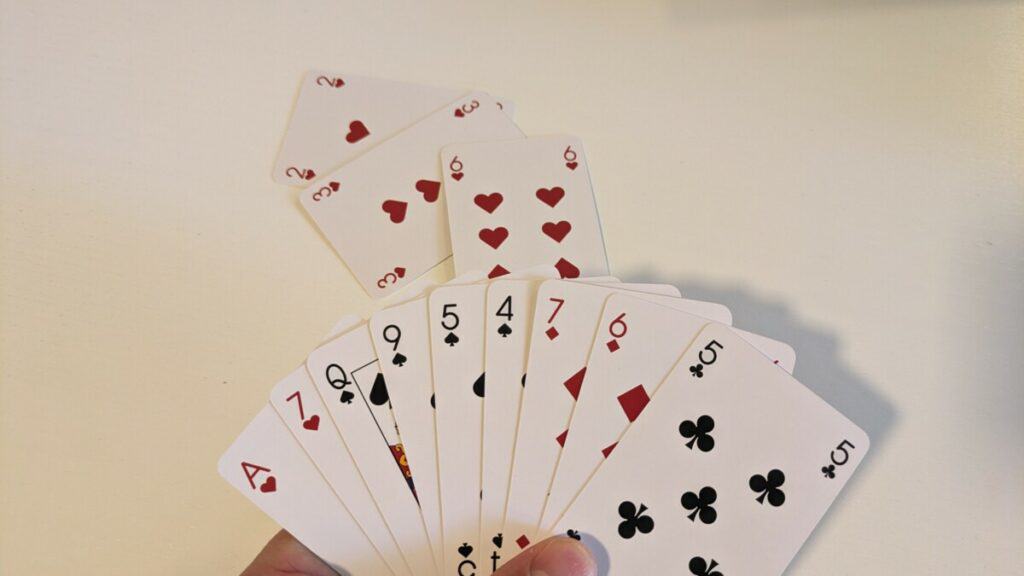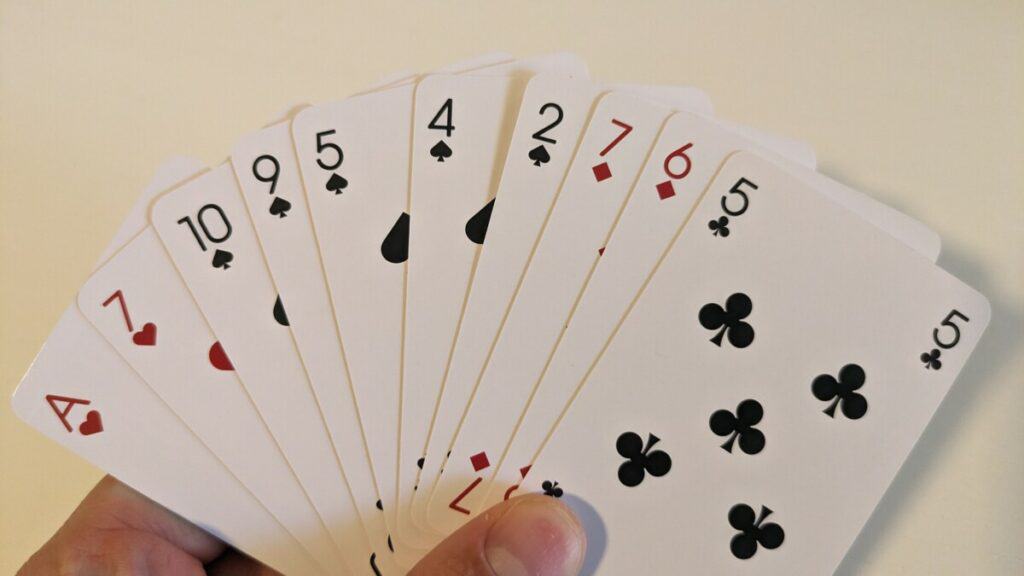
Hearts is a classic card game that combines the luck of the draw with a great deal of strategy. This is my all-time favorite card game and I’ve played it thousands of times with friends, family, and online. Over the years I’ve learned every trick in the book (pardon the pun) to become a deadly Hearts player. These Hearts strategies will help you to win more often and have fun while doing it.
In general, the best Hearts strategies are to void Clubs and Diamonds early, protect yourself from the Queen of Spades, and plan your strategy for the first trick. You should also keep tabs on high Hearts and Spades, pay attention to the cards passed to you, and try to Shoot the Moon if possible.
The beauty of Hearts is that every hand is different based on the cards you’re dealt. However, there are a lot of overarching strategies and principles that, if fully understood and implemented, will have you coming out ahead in the long run. I’ll go into how and why to implement each of these strategies so that you can effectively apply them in your own games.
Pass the 2 of Clubs for an early advantage

We’ll first go over a few strategies involving passing cards at the start of every round. One of the most universally adhered-to strategies is to pass the 2 of Clubs to another player. Having to play the 2 of Clubs on the first trick of the game is a significant disadvantage. You don’t get to play a higher, more dangerous card and it’s impossible for you to take control of the next trick. If possible, always pass the 2 of Clubs off to another player so that you have the option to make a more strategic play on the first trick.
The only time you may not want to pass the 2 of Clubs is if the rest of your hand is a mess and you need to unload more dangerous cards. For example, if the only Spades you have are the Queen and King of Spades and the only Heart you have is the Queen of Hearts, then it might be best to pass those three cards off and keep the 2 of Clubs.
TIP: Check out my article about how to Shoot the Moon like a pro!
Hold the Ace of Clubs to take control
In a similar vein, you should almost always keep the Ace of Clubs instead of passing it. I used to pass it if it would void a suit (more on this later) but I have found that it’s usually better to keep it and play it on the first trick.
By playing the Ace of Clubs first you win the first trick (risk-free, since points can’t be played) and you get to control the game by starting the second trick. If the Ace was your last Club then you also haven’t tipped off other players that you have voided the suit, making it more difficult for them to judge your strategy for the hand.
Pass the Queen of Spades judiciously

The Queen of Spades is the most powerful and dangerous card in Hearts, so deciding what to do with her if she’s dealt to you is a critical decision. In general, if you have 3 or more other Spades (especially 2 through Jack) you should keep the Queen of Spades so that you can better control when she gets played. This is even more effective if you are close to voiding one or two suits, which would make it easier to dump her off.
CHECK IT OUT: Do you struggle to hold and rearrange 13 cards in your hand? My daughter does, so we got her these really handy curved wooden card holders (link to Amazon) to make things more enjoyable for her.
You should almost never pass the Queen of Spades to your left. Doing so would give the player to your left the ability to play her as the last card of a trick you are currently controlling. It’s dangerous to leave your fate in the hands of another player like that.
Conversely, passing the Queen of Spades to your right is usually a good strategy. This way, you get the last say over any trick in which she is played. You can also safely play the King and Ace of Spades on any trick in which the player to your right has already played.
Stay safe by never passing low Spades
Low Spades in Hearts are like a warm blanket on a cold night. They give you a sense of security as a buffer between you and the dreaded Queen of Spades. Every Spade lower than the Queen (2 through Jack) gives you a lifeline whenever Spades are led in a trick. Never pass these low Spades from your hand, since you’d only be giving away a valuable commodity.
CHECK IT OUT: I have also written a complete strategy guide to Spades, another super popular trick-taking game.
Some newer players think that they can risk passing their low Spades in an effort to void the suit, but this is often a crippling mistake if they are passed the Queen, King, and/or Ace of Spades.
Void Clubs and Diamonds early
‘Voiding’ a suit is the term given to getting rid of that suit from your hand entirely. This is one of the most common strategies in Hearts and it also happens to be my favorite. It gives you the flexibility to play any card from your hand if a card from that suit is led, allowing you to play dangerous and undesirable cards.
Since more Spades give you a buffer from the Queen of Spades and Hearts give you the ability to play points on other players, Clubs and Diamonds are the suits that experienced Hearts players try to void as soon as possible. I will often go so far as to void a second suit early on, even if it means playing a harmless Club or Diamond before a more dangerous card.
Take tricks with your highest possible card

No matter how well you play, you will take tricks during a game of Hearts and some of them will be painful. However, if you are going to take a trick you should almost always take it with the highest card of that suit.
Since you’re going to take the trick regardless, it does you no good to take it with a lower card. By taking it with your highest card you save your lower cards for later in the game when you may be able to avoid taking the trick/points entirely. The only exception to this strategy is if you are trying to Shoot the Moon or prevent another player from doing so.
Flush out the Queen of Spades

If you have a lot of Spades in your hand and control of the game it’s often a good idea to flush out the Queen of Spades. My dad used to affectionately refer to this as ‘going fishing’. By repeatedly leading with Spades you eat away at the buffer of the player holding the Queen of Spades, eventually forcing her to be played.
To use this strategy effectively, you first need quite a few low Spades (2 through Jack). Start with your highest Spade and, if you win the trick and retain control, continue playing Spades in descending order. If you have enough Spades, eventually the Queen, King and/or Ace of Spades will be forced out of hiding.
Keep track of high Hearts and Spades
There are some cards in Hearts that everyone groans at when they pick up their hand after a deal. In general, the least desirable cards in Hearts are the Ace, King, and Queen of Spades and the Ace and King of Hearts.
These cards often end up dictating who takes the most points in a hand of Hearts, so it’s worth paying extra close attention to them. Take note of when they’re played so that you know whether they’re still in a player’s hand or not. This can often dictate whether or not it’s safe to play other cards in your hand, and can sometimes be an early warning sign of someone Shooting the Moon.
Play the Ace and King of Spades on a voided suit
With that in mind, it’s generally a good idea to get rid of these undesirable cards as soon as possible. I always like to err on the side of caution, so if I get the opportunity to ditch the Ace of King of Spades I’ll always take it.
Some players might prefer to get rid of a high Heart card instead, fearing that they’ll end up taking a trick of Hearts. However, the risk of holding the Ace and King of Spades without a solid buffer of lower Spades is far greater than the possibility of taking a few points from Hearts.
Hold a high Heart in reserve
Sometimes it’s a good idea to hold a high Heart card on purpose. A common strategy is to always keep the Ace of Hearts if it’s dealt to you, and instead of viewing it as a liability, you keep it as insurance against another player Shooting the Moon.
If you keep the Ace of Hearts it will be virtually impossible for another player to Shoot the Moon. You can just take a few points in one trick to save you and the rest of the players from taking 26 points. Additionally, keeping the Ace of Hearts leaves open the possibility of you being able to Shoot the Moon, especially if another player passes you some high Hearts.
CHECK IT OUT: I have also written a complete strategy guide to Wizard, a unique trick-taking card game that can be played with 3 to 6 people.
Keep some low Hearts for flexibility
If you are dealt low hearts (7 or lower, in general) then you should almost always keep them in your hand. They are a great way to insure against taking a lot of Heart tricks while also allowing you to dole out punishment when you’ve voided another suit.
Keeping low hearts in your hand makes it much less stressful when an opponent passes you the Ace or King of Hearts since it gives you time to void a suit and get rid of them.
Pile points onto the current leader
This tip is universal to almost every game with more than 2 players. If a player is winning (especially if its by a wide margin) you should do everything you can to bring them back to the pack. The most obvious way to do this is to try to hit them with the Queen of Spades, but you can also preferentially play hearts on them throughout a hand.
An unspoken (or sometimes even outwardly spoken) bond often forms amongst Hearts players when one player is way in the lead. Sometimes you can use this bond with other experienced Hearts players to cooperate against the leading player. Try passing the Queen of Spades and some extra lower spades to the player to the left of the leading player. A card pass like this says, in no unsubtle terms, that they should use those cards to eventually dump the Queen of Spades on the leading player.
Utilize runs of consecutive cards in your hand

A subtle trick of mine that I’ve developed over the years is the concept of ‘equal value cards’. When you have a consecutive run of cards in one suit, they are all effectively the same card to you because they form one solid block.
For example, if you have the 6, 7, 8, and 9 of Diamonds they can all be treated as the same card. Taking a trick with the 6 of Diamonds is effectively the same as taking it with the 9 of Diamonds, but no other players have cards in between those two.
However, other players don’t know you have this run, so they perceive the cards as having different values. Strategically playing a card on the high or low side of your run has the potential to deceive your opponents by making them think that the rest of those cards must be more evenly distributed amongst other players. In the most general sense, you should play the card that seems the least natural from your run.
Make inferences based on what you’re passed
You can tell a lot about a player’s strategy based on what cards they have passed to you. If they pass three innocuous-looking Diamonds, you can be fairly certain that they are trying to void Diamonds so you should be wary of leading with a high Diamond. Similarly, if they pass some high Heart cards they probably thought they didn’t have enough low Hearts to insulate them.
If you get a hand full of suspiciously low-looking cards then that is probably a sign that the player who passed them is going to try to shoot the moon. In this case, you would do well to keep a high Heart in reserve if possible to prevent them from doing so.
Look for early signs of Shooting the Moon
Passing low cards is just one early indication of Moon Shooting. Players leading with strangely high cards is a dead giveaway that they’re going for it, but more experienced players will be more subtle about it. They will often start with more mid-range cards to bleed out specific cards they’re worried about before changing gears and playing their highest cards.
Another dead giveaway of a player Shooting the Moon is if they take an early Heart that otherwise seems completely unnecessary. If they play a Jack of Diamonds to take a Heart and then lead with a lower Diamond that would have avoided the Heart completely, you can be pretty confident that they’re trying to Shoot the Moon.
Shoot the Moon if your cards allow it
Shooting the Moon is a delicate art, but Hearts requires that you adapt your game for the cards you’ve been dealt. And let’s face it – Shooting the Moon is fun! There are some types of hands that are conducive to going for it:
- Having the Ace, King, and Queen of Hearts
- Having 7+ cards in one suit and the rest are high cards
- Don’t have a ‘losing Heart’ (low Heart) that’s impossible to safely play
- High cards in every suit
I have written an entire article about how to Shoot the Moon where I explain all of the tips and tricks I’ve learned over the years.
There are a virtually unlimited combination of hands you can have in Hearts and very few will give you a guarantee of Shooting the Moon. However, with some foresight and clever deception it’s often worth trying it. If nothing else, it makes the game more fun for everyone.
Thanks for reading! If I missed something or you have your own opinions, please drop a comment below.
What is thr benefit of along out first in hand? Seems to me like you would never want to assume…
Your strategy comments are excellent, well thought out and very helpful! Thank you
You would only get to draw and play a Sanctuary card on turn two of round one if the Region…
Rule question. If in phase one of round one I play a Region card with a Clue symbol at the…

Leave a Reply